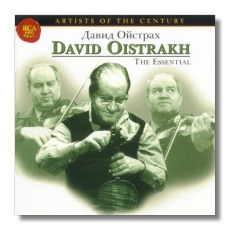
The Internet's Premier Classical Music Source
Related Links
- Latest Reviews
- More Reviews
-
By Composer
-
Collections
DVD & Blu-ray
Books
Concert Reviews
Articles/Interviews
Software
Audio
Search Amazon
Recommended Links
Site News
 CD Review
CD Review
The Essential David Oistrakh

Violin Concertos
- Wolfgang Mozart: Concerto for Violin #1 in B Flat Major, K 207
- Johannes Brahms: Concerto for Violin in D Major, Op. 77
- Ludwig van Beethoven: Romance #1 for Violin and Orchestra in E Major, Op. 40 *
- Ludwig van Beethoven: Romance #2 for Violin and Orchestra in F Major, Op. 50 *
- Dmitri Shostakovich: Concerto for Violin #1 in A minor, Op. 77 **
- Dmitri Shostakovich: Concerto for Violin #2 in C Sharp minor, Op. 129
David Oistrakh, violin
Moscow Philharmonic Orchestra/Kirill Kondrashin
* Moscow Philharmonic Orchestra/Gennady Rozhdestvensky
** Leningrad Philharmonic Orchestra/Yevgeny Mravinsky
RCA Red Seal 74321-72914-2 ADD partly monaural 2CDs 76:41, 66:35
This is a new release in RCA's "Artists of the Century" series, and it draws on recordings that David Oistrakh made for the Soviet Melodiya label between 1956 and 1968. If there are music-lovers who haven't become acquainted with this great violinist/conductor, who was born in 1908 and died in rehearsal in 1974, this is a great opportunity. These two discs sell for the price of one, and both the performances and (for the most part) the sound are excell
The Odessa-born Oistrakh started his international career with competition victories while he was still in his twenties, but the Stalin regime soon limited his travels abroad. A famous "thaw" occurred in 1955, when he finally came to the United States to play recitals… and to play Shostakovich's First Violin Concerto with the New York Philharmonic and Dimitri Mitropoulos. They completed the first recording of this work on January 2, 1956; the recording presented here was made later that year, after Oistrakh returned to the Soviet Union. It is interesting to compare the two. Tempos are almost the same, but the Soviet recording seems tenser; the New York recording more elegiac. Could the difference have been the conductors? Mitropoulos was the long-suffering saint, Mravinsky the tyrant who made everyone suffer. It only goes to show that there's more than one way to interpret a violin concerto. The Soviet recording has its sonic limitations, but they don't matter much with music-making such as this. The Second Violin Concerto was recorded in 1967 with Kondrashin in Moscow, not long after the work's première. (As before, Oistrakh then played it in the United States.) Shostakovich wrote this concerto specifically for Oistrakh, and no one has surpassed him or this particular recording since; Oistrakh is sympathetic to the music's tentative steps toward human reconciliation.
RCA bills the Mozart, Brahms, and Beethoven as first releases. The Mozart and Brahms were recorded on the same night in February 1963, in concert with Kondrashin and the Moscow Philharmonic. These are strong, assertive readings, inspiringly so in the Brahms, which too often is played as if in a state of fear or Apollonian disinvolvement. Oistrakh's warm tone ensures that the concerto's melodic content is not compromised, in spite of his gutsy playing. The Mozart, particularly the contribution of the orchestra, has little to do with Classical style, yet Oistrakh's sunny disposition ensures enjoyment here. The two Beethoven Romances were played a few days before the violinist's 60th birthday; here, Rozhdestvensky is the conductor. The audience's ready applause at the end of the second Romance is in recognition of the especially affectionate relationship on this occasion between Oistrakh and Beethoven's music, as well as between the violinist and the orchestra; it is rare to feel such dialogue among performers.
Copyright © 2000, Raymond Tuttle


















